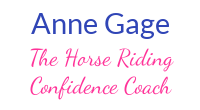Whether you’re suffering from ‘show nerves’ or are afraid to ride at all, you may have been told by your friends, your coach, or even said to yourself – “It’s just in your head”.
It’s true that fear exists in our brains. There’s a perfectly natural and instinctive program that starts automatically when our brains believe we are in danger. It’s meant to keep us safe and prevent us from doing things that could cause us physical harm. The problem is that when it interferes with your enjoyment of riding or showing, then fear is no longer your friend.
Your brain can’t tell the difference between a real or an imagined danger. So, when we ‘think’ we might be hurt in some way, that fear alarm is triggered. The perceived ‘hurt’ might be potential physical injury or emotional (i.e. embarrassment, judgment, etc.)
The good news is that you can take control and manage that fear – whether it’s a mild feeling of stress, a stronger anxiety or an outright shaking in your boots fear.
You solve any problem at the root of it. And, the root of the fear is in your head – your thoughts.
When fear controls your thoughts, you go into that negative spiral of the ‘what if’s’.
You ‘think’ that whatever you are about to do is not going to end well. So, riding becomes miserable instead of fun.
The good news is that you can influence your thoughts to build your confidence. To control those show nerves. To enjoy riding your horse.
Change your thoughts and you change how you feel.
Simple advice. But most people struggle with it. Following these 3 steps will help you successfully change you mind by retraining it.
Step #1 – Be aware of what you are thinking and saying. You have about 50,000 thoughts every day! And you’re unaware of most of them. As you go through your day, notice how often you use dis-empowering, negative phrases.
Do any of these phrases sound familiar?
- “I don’t know what to do!”
- “I’m stuck.”
- “This won’t work.”
- “This is too much for me.”
- “I’ll never get this.”
Notice the emotions you have when you think or talk this way.
Step #2 – Write down your thoughts. Keep a journal (on paper or digitally) where you record your negative thoughts. Write them down as soon as they happen (or as soon afterward as you can) so that you can record them as accurately as possible.
Note what was going through your mind and what you were doing at that moment.
Also, notice the emotions you were feeling. What came first, the thought or the feeling?
You may find writing down negative thoughts and feelings difficult. You may prefer not to face them, feel afraid, or even think they are stupid.
But, ignoring the negative thoughts and feelings won’t make them disappear – it just makes them stronger. You’ll deal with them in the next step.
Step #3 – Flip those negative thoughts on their heads. Once you’ve recorded and become aware of your most common negative thoughts then you can re-write them into empowering phrases that build your confidence.
Simply by changing a negative to a positive statement or question, you give your unconscious mind a problem to solve. And your brain loves solving problems!
So, give it something positive to focus on and it will go to work figuring out an answer.
You will move forward. It will work. You will be able to handle it. And you will get it.
5 more examples of confidence-breaking phrases and their confidence-building alternatives:
“I’m afraid my horse will spook” becomes “I admit that I have a fear my horse will spook. What help can I get to work through this?”
“I hope I don’t fall apart in the show” becomes “I have prepared myself and my horse well for this show. We will do our best and learn from the experience.”
“I can’t do what my coach wants me to do” becomes “There’s something I’m not getting yet. I can ask for more help and I can practice more. I know I will get it eventually.”
“I’ll never get these transitions right” becomes “We’ve only been working on these movements for a short time. It takes time to get them consistently.”
“I can’t afford riding lessons or training” becomes “This is something that’s really important to me. I need xx dollars. I just need to figure out a way to make that extra money.”
Taking these 3 steps may seem difficult at first. But the more often you do it, the more natural it becomes. Practice changing your thoughts to evoke positive emotions and your confidence will grow.

